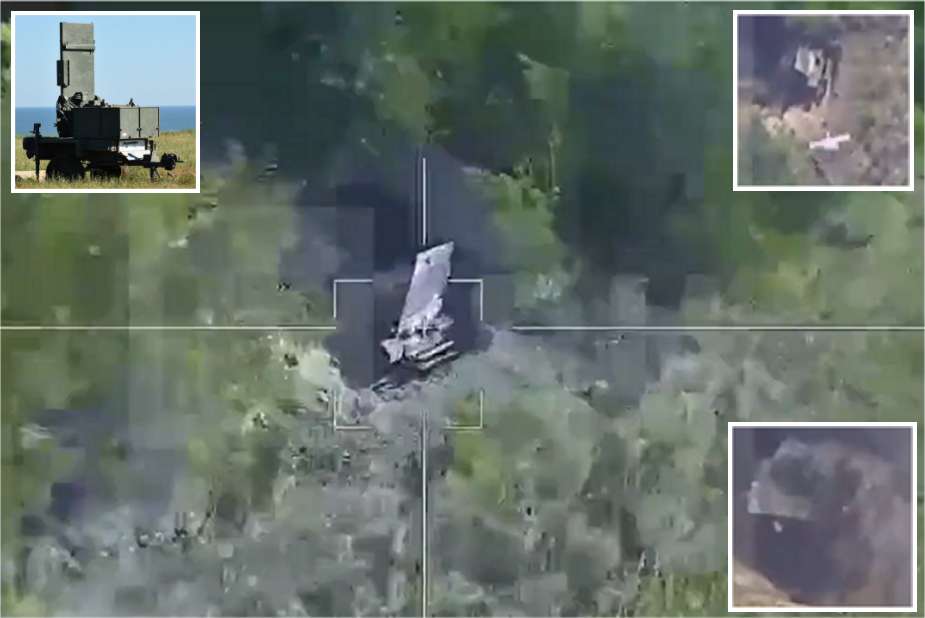- Army
- Conflicts in the world
- Israel - Iran conflict 2025
- Pakistan - India Conflict 2025
- Russia Ukraine War 2022
- Libya conflict day by day
- HAMAS - Israel War 2023
- Operation Serval in Mali French Army
- Sangaris operation Central African Republic
- Sangaris opération militaire République Centreafrique
- Ukraine - Russia conflict
- Syria conflict news
- Defence & Security Industry Technology
- Armies in the world
- Analysis Defense and Security Industry
- Conflicts in the world
- Navy
- Air
Russian Lancet drone destroys US-supplied Ukrainian AN/TPQ-36 counter-artillery radar
According to a tweet by JohnMT on August 21, 2023, a Russian ZALA Lancet loitering munition targeted and destroyed a Ukrainian AN/TPQ-36 counter-artillery radar. Records show that the United States began supplying these radars to Ukraine in 2015, with a total of 74 units delivered by August 2023.
Follow Army Recognition on Google News at this link

Russian kamikaze drone destroyed US-supplied Ukrainian AN/TPQ-36 counter-artillery radar (Picture source JohnMT and Wikimedia)
The targeting of the AN/TPQ-36 counter-artillery radar underscores the strategic importance of such equipment in the conflict. Counter-artillery radars, like the AN/TPQ-36, are specifically engineered for rapid detection, and play a pivotal role in identifying the exact origin of enemy artillery fire. Once the source is identified, the data relayed by these radars can be used to formulate potential counter-fire strategies, aiming to neutralize the identified enemy artillery positions.
Beyond their primary function, these radars serve an additional, equally vital role: they function as an early warning system for troops stationed at the frontline. By alerting soldiers to imminent artillery threats, they provide a crucial window of time for evasive actions, thereby reducing potential casualties. However, the removal or incapacitation of such a radar system creates a significant vulnerability. Troops could be exposed to unanticipated artillery fire, leading to potential disruptions in tactical operations. This could also necessitate the diversion of resources to replace the lost equipment, straining logistical and financial resources.
Moreover, the absence of a counter-artillery radar like the AN/TPQ-36 can tilt the balance in favor of the offensive side. Without the defensive side's ability to swiftly detect and respond to artillery threats, the dynamics of engagement could shift, potentially compromising defensive strategies. Such a loss isn't just a tactical setback; it can also have psychological implications. Soldiers, knowing they're without the protective umbrella of early detection, might experience a decline in morale, affecting their overall combat readiness and performance.
Additionally, these radars are not just tools of detection; they are also vital intelligence assets. They gather and relay information about enemy artillery positions, the types of weapons in use, their firing sequences, and other patterns. This intelligence is crucial for commanders to understand the broader battlefield environment and to make informed strategic decisions. Without access to this stream of intelligence, the defending force's comprehensive understanding of enemy operations could be hampered, potentially leading to tactical and strategic disadvantages.
The Lancet, also referred to as Item 52/Item 51, is a UAV and loitering munition developed by Russia's ZALA Aero Group. Introduced at the ARMY-2019 military expo in Moscow, this aerial tool has functionalities for both reconnaissance and offensive operations. It comes with optical-electronic guidance, a TV guidance module, and systems for intelligence, navigation, and communication.
The Lancet, a UAV and loitering munition, was developed by the Russian company ZALA Aero Group and is officially known as Item 52/Item 51. It was introduced at the ARMY-2019 military expo in Moscow and is designed for both reconnaissance and strike missions. The Lancet is equipped with optical-electronic guidance and a TV guidance system, allowing for precise control during its flight's final phase. Additionally, it integrates modules for intelligence, navigation, and communication, enhancing its operational functions.
A notable capability of the Lancet drone is its "air mining" function. This allows the UAV to dive at speeds reaching 300 kilometers per hour, targeting and potentially neutralizing enemy unmanned combat aerial vehicles (UCAVs) during flight. With a range of 40 kilometers and a 12-kilogram takeoff weight, the drone can deploy high-explosive or HE-fragmentation warheads accurately, making it a significant tool for the Russian military.
The Izdelie-53, a newer variant of the Lancet, has seen increased use. It features a tube launcher that can hold multiple Lancet drones and a sophisticated communication system for potential autonomous targeting and synchronized attacks. Given the heightened tensions in Ukraine, Russia has amplified its Lancet drone production threefold to address military requirements.
The AN/TPQ-36, manufactured in the United States, is a counter-artillery radar system. Its primary function is to swiftly and autonomously detect medium-range enemy mortars, artillery, and rocket launchers. Capable of processing data from multiple firing sources simultaneously, it can relay their locations after the initial shot. This system minimizes the exposure of frontline units to prolonged enemy artillery engagements by guiding counter-fire to target enemy sites.
Designed for mobility, the AN/TPQ-36 can be quickly deployed. A team of five can set it up within 15 minutes and prepare it for relocation in just 5 minutes. It boasts a detection range of 18 km for artillery and 24 km for rockets. Furthermore, the system can provide data on the positions of up to ten different weapon sources within its maximum range and offers feedback to refine allied artillery fire.


























